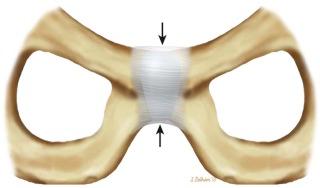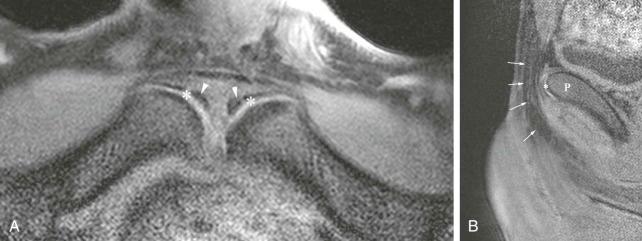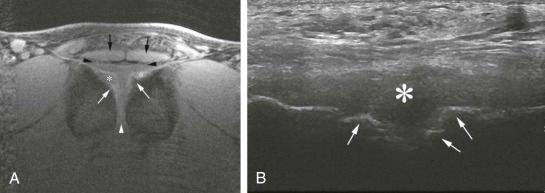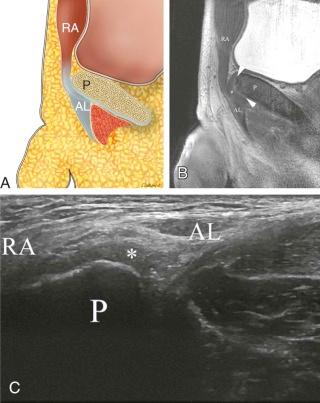Physical Address
304 North Cardinal St.
Dorchester Center, MA 02124
The pubic symphysis is a nonsynovial, amphiarthrodial joint formed by the confluence of the two pubic bodies with an intervening articular disk ( Fig. 21-1 ). The medial surface of the body forms the articular surface and is ovoid, covered by a thin layer of hyaline cartilage and composed of undulating transversely oriented ridges and grooves that can help dissipate loading and shear forces.

The pubic apophysis is a relatively thin growth plate covering the anteromedial pubic body, separated from the main body by cartilage ( eFig. 21-1 ). The plate can fuse relatively late (up to midtwenties) and can appear irregular on MR imaging and ultrasonography normally because of variation in the degree of ossification ( eFig. 21-2 ). The pubic crest arises from the upper margin of the body and projects anteriorly, and the pubic tubercle arises from the lateral aspect of the crest. The fibrocartilaginous articular disk is interposed between the pubic articular surfaces, and its main function is to absorb and dissipate axial and shear forces (see eFig. 21-2 ; eFig. 21-3 ).



The joint is supported by four ligaments: superior, arcuate (or inferior), anterior, and posterior pubic. The superior pubic ligament attaches at the pubic tubercles. The arcuate ligament is a fibrous band condensation in the inferior aspect of the joint and has an attachment to the articular disk and merges inferiorly with the aponeurosis of the adductor longus and gracilis tendons. The anterior pubic ligament has deep and superficial layers. The deep layer attaches to the articular disk, and the superficial layer merges with the aponeurosis of external oblique and rectus abdominis muscles. The posterior pubic ligament is composed of a few transversely oriented fibers and is the least developed of these ligaments.
The pubic symphysis is also stabilized by several musculotendinous structures, which attach onto the anterior and superior aspects of the joint, its capsule, and margins. These structures include the hip rotators, oblique abdominal, rectus abdominis and adductor group muscles, tendons, and aponeuroses. Anatomically, these structures are continuous with the lower rectus abdominis sheath also blending with the medial inguinal canal ligaments and aponeuroses ( Fig. 21-2 ; see eFig. 21-3 ). There is also prominent variation in the nerve supply to this region, which may explain the variety in presenting symptoms that can involve the medial thigh, perineum, lower abdomen, and inguinal region.

It is difficult to determine whether the decreased incidence of pubalgia in female athletes is due to differences in anatomy or the intensity and types of sport performed. One of the main anatomic differences is the increased volume and patency of the inguinal canal in males. Additionally, in males, it has been described that the medial half of each rectus abdominis continues distally in a ligament that runs over the anterior symphysis to confluence bilaterally with the gracilis and fascia lata (see eFig. 21-1B and Fig. 21-2 ). This has been termed rectogracilis ligament, whereas, in females, the medial half of each rectus abdominis continues also as a ligament but inserts and terminates onto the anterosuperior part of the symphysis. The fibers extending from the inguinal ligament also divide the anterior side of the pubis into a lower and upper half. In females, this extension runs over the whole anterior side of the pubis, and fibers from the left side merge with fibers from the right side. In males, these extensions do not cross the midline, being separated by the rectogracilis ligament.
Become a Clinical Tree membership for Full access and enjoy Unlimited articles
If you are a member. Log in here